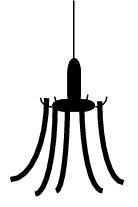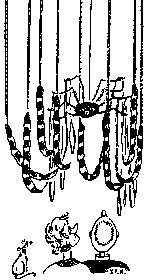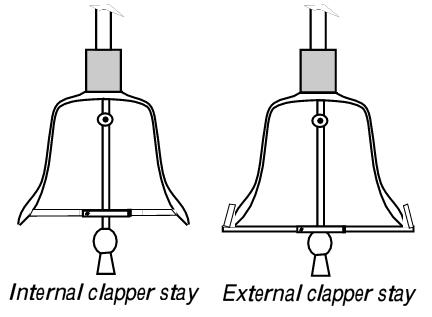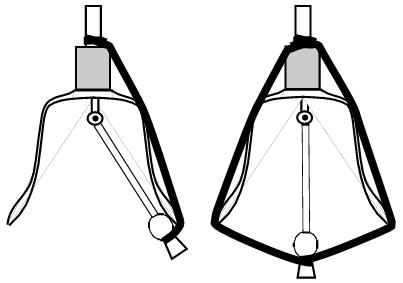The Tower Handbook
6.4: Practicalities
a: What will help us keep the tower clean?
- A wastepaper bin
Encourage people to use it, and don't forget someone must empty it.
- A cleaner
A vacuum cleaner is best. Perhaps you know someone who has an old one to give away. A small carpet sweeper is OK for a weekly tidy up, but won't get in the corners, and can be hard work if the dirt builds up. If you have a hard floor, a sweeping brush and dust pan may be adequate.
- Everyone being prepared to do their share
See section 3.6c.
b: How can we keep ropes out of the way when not in use?
 When you are not ringing, it is a good idea to move the ropes out of the way, especially in a small ringing chamber. You can tie them as normal and then hang them on hooks on the wall. Some towers that do this have the bell number by each hook so visitors don't need to guess which bell is which.
When you are not ringing, it is a good idea to move the ropes out of the way, especially in a small ringing chamber. You can tie them as normal and then hang them on hooks on the wall. Some towers that do this have the bell number by each hook so visitors don't need to guess which bell is which.
A more elegant solution is a spider - an object with enough hooks or pegs to hang all the ropes on.
 Spiders come in all shapes, sizes and materials. Some even look like spiders! A spider hangs on the end of a cord or rope from a pulley on the ceiling, so it and the ropes can be pulled up out of harm's way. It must be heavy enough to come down under its own weight when no ropes are on it. If possible hang it where it could not fall on anyone if suddenly released. Otherwise, make sure it is well padded underneath.
Spiders come in all shapes, sizes and materials. Some even look like spiders! A spider hangs on the end of a cord or rope from a pulley on the ceiling, so it and the ropes can be pulled up out of harm's way. It must be heavy enough to come down under its own weight when no ropes are on it. If possible hang it where it could not fall on anyone if suddenly released. Otherwise, make sure it is well padded underneath.
If you can't lock your ringing room to control access, you can padlock the end of the rope holding the spider so the ropes cannot be tampered with.
c: Should we have rope mats?
Rope mats look more interesting than a blank expanse of floor, and they help to reduce the wear on your tail ends. Some towers have mats made with suitable patterns (a bell picture, or the number of the bell), while others scrounge carpet samples from a shop. If you do this, make sure they are woollen carpet samples, since synthetic fabrics wear ropes as much as a smooth wood floor. A soft mat will reduce rope wear especially if you have a stone floor. If you have a stone floor you may want the mats big enough to be able to stand on as well in cold weather.
d: How can we keep toddlers under control?
 Many ringing parents have to choose between taking it in turns to come to ringing on a Sunday morning and bringing their children with them. Some towers (with the space) find that a play pen is an invaluable amenity. Others hitch their toddler's harness to a chair (like hitching up a horse). Of course most children do not need 'caging up', just 'keeping an eye on'. This can be easier if there is a corner where they can move around a little without risk of coming into the rope circle.
Many ringing parents have to choose between taking it in turns to come to ringing on a Sunday morning and bringing their children with them. Some towers (with the space) find that a play pen is an invaluable amenity. Others hitch their toddler's harness to a chair (like hitching up a horse). Of course most children do not need 'caging up', just 'keeping an eye on'. This can be easier if there is a corner where they can move around a little without risk of coming into the rope circle.
e: Should we have different size boxes?
Since people are different sizes it would be a good idea. If you are making new ones, why not vary the area a little as well as the height, so they can be stacked inside each other when not in use? Slots in the end are better than handles that stick out, as they avoid the risk of a rope catching and tipping up the box. The top should be flush with the sides, with smooth edges.
f: Can we cut down the sound level in the ringing room?
Most towers have something between the bell chamber and the ringing room to reduce the sound transmission. It may be a false floor, layers of sawdust or any other absorbent material. It may be that the sound level coming down to you is not excessive, but the ringing room reverberates like a bathroom. Having a carpet or thick curtains will help. Some towers have also attached layers of sound absorbent material on the wall. Glass wool slabs are quite good, but need covering with something like polythene to prevent the itchy fibres from catching on people as they brush past.
g: Can we augment the sound in the ringing room?
Some bells are too quiet in the ringing room, making them difficult to hear. You may be able to open a trap door partly, or to remove some material from between floors. If these simple solutions are not possible, you could do as a few towers have and place a microphone in the bell chamber amplified through a loudspeaker in the ringing room. You will need an omni-directional microphone of reasonable quality to cope with the loud sound and you will have to experiment to find a good place to put it. High above the bells (or in the clock room immediately below) will often avoid it being too close to any single bell upsetting the sound balance. Near the top of the stairs is sometimes effective too.
h: What can we do about the sound of bells in the church?
If your ringing room is open to the church, you probably find you cannot ring up to the service because the organist wants several minutes to play, and after weddings, you cannot hear the bells very well while the wedding march is being played. Unless you can provide some sort of screen to reduce the sound, you will just have to keep on good terms with the organist and agree a compromise.
If your tower is not open to the church, the bells may not be audible inside at all. This is a pity since for half an hour or more you are performing as an integral part of the service, but those in the church cannot hear you. A solution to this would be to use a microphone in the bell chamber (as in the previous answer) which can be fed through the church PA system until the organist starts to play.
i: How can we quieten a bell for handling practice?
There are several ways. The traditional methods silence the bell completely.
 Use a clapper stay.
Use a clapper stay.
It clamps round the shaft of the clapper held with a wing nut and fit snugly inside the bell holding the clapper in the middle of the bell. Some forms of clapper stay have lugs to fit over the outside of the bell, but they are more awkward to use and more prone to break where the lugs are attached.
 Tie the clapper.
Tie the clapper.
Use a length of rope to hold it against one side of the bell. The clapper must be held firm or it will tap the bell and make a noise [55]. Tying the clapper on one side affects the balance of the bell, making it lighter set on one stroke (at handstroke if the clapper is on the same side as the rope when the bell is down).
Alternatively you can use a piece of rope on each side to hold the clapper in the middle of the bell. This takes significantly longer to fit but cannot produce any sound, even if it works slightly loose [56].
For initial instruction it is better to quieten the bell, so it is audible inside but still very quiet outside. This helps your trainees to develop an awareness of the relationship between when the bell strikes and the movement of the rope.
- The Launton quietener No1
A clapper tied at the side of the bell, but with about an inch of movement so the clapper can move and tap the bell gently.
- The Launton quietener No2
A clapper stay with a clapperette (tiny clapper) on one end which taps the bell as it swings.
 A 'car tyre muffle'
A 'car tyre muffle'
A section cut from an old car tyre with a hole and slots cut in the tread so it can be pushed over the clapper flight. The walls of the tyre form soft pads through which the clapper strikes the bell. For a little bell you may need to grind off some rubber to make the sound audible and/or stop the clapper bouncing excessively When not needed, the muffles can be turned through 90_ to allow ordinary ringing (providing the sections are not cut too wide).- Sound control
Variable shutters closing the louvres can if well designed reduce the sound to a level which is only just audible and not disturbing outside. See section 14.10.
Finally, you can replace the sound of the bell.
Use a simulator
The bell is fitted with a photo head to detect the passage of reflective strips stuck on the wheel(some use a magnetic sensor instead). The bell is silenced, as above when required and the simulator in the ringing chamber generates an electronic sound.
j: Should we number the bells?
Although you may know which bell is which, visitors may not. It is quite simple to place a number on the wall behind each.. The sort of metal or plastic figures used for numbers are quite good. Some towers do things in style and have the number worked into the pattern of each individual ringing mat.
Previous

 Next
Next
Currently hosted on jaharrison.me.uk
 When you are not ringing, it is a good idea to move the ropes out of the way, especially in a small ringing chamber. You can tie them as normal and then hang them on hooks on the wall. Some towers that do this have the bell number by each hook so visitors don't need to guess which bell is which.
When you are not ringing, it is a good idea to move the ropes out of the way, especially in a small ringing chamber. You can tie them as normal and then hang them on hooks on the wall. Some towers that do this have the bell number by each hook so visitors don't need to guess which bell is which. Spiders come in all shapes, sizes and materials. Some even look like spiders! A spider hangs on the end of a cord or rope from a pulley on the ceiling, so it and the ropes can be pulled up out of harm's way. It must be heavy enough to come down under its own weight when no ropes are on it. If possible hang it where it could not fall on anyone if suddenly released. Otherwise, make sure it is well padded underneath.
Spiders come in all shapes, sizes and materials. Some even look like spiders! A spider hangs on the end of a cord or rope from a pulley on the ceiling, so it and the ropes can be pulled up out of harm's way. It must be heavy enough to come down under its own weight when no ropes are on it. If possible hang it where it could not fall on anyone if suddenly released. Otherwise, make sure it is well padded underneath. Many ringing parents have to choose between taking it in turns to come to ringing on a Sunday morning and bringing their children with them. Some towers (with the space) find that a play pen is an invaluable amenity. Others hitch their toddler's harness to a chair (like hitching up a horse). Of course most children do not need 'caging up', just 'keeping an eye on'. This can be easier if there is a corner where they can move around a little without risk of coming into the rope circle.
Many ringing parents have to choose between taking it in turns to come to ringing on a Sunday morning and bringing their children with them. Some towers (with the space) find that a play pen is an invaluable amenity. Others hitch their toddler's harness to a chair (like hitching up a horse). Of course most children do not need 'caging up', just 'keeping an eye on'. This can be easier if there is a corner where they can move around a little without risk of coming into the rope circle. Use a clapper stay.
Use a clapper stay. Tie the clapper.
Tie the clapper. A 'car tyre muffle'
A 'car tyre muffle'